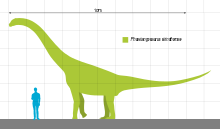ภูเวียงโกซอรัส
| ภูเวียงโกซอรัส ช่วงเวลาที่มีชีวิตอยู่: Valanginian ตอนปลาย - Hauterivian ตอนต้น, ~133.6–132.1Ma | |
|---|---|

| |
| กระดูกต้นขา | |
| การจำแนกชั้นทางวิทยาศาสตร์ | |
| โดเมน: | ยูแคริโอตา Eukaryota |
| อาณาจักร: | สัตว์ Animalia |
| ไฟลัม: | สัตว์มีแกนสันหลัง Chordata |
| เคลด: | ไดโนเสาร์ Dinosauria |
| เคลด: | ซอริสเกีย Saurischia |
| เคลด: | †ซอโรโพโดมอร์ฟา Sauropodomorpha |
| เคลด: | †ซอโรพอด Sauropoda |
| เคลด: | †Macronaria |
| วงศ์: | †Euhelopodidae |
| สกุล: | †ภูเวียงโกซอรัส Martin, Buffetaut and Suteethorn, 1994 |
| ชนิดต้นแบบ | |
| †Phuwiangosaurus sirindhornae Martin, Buffetaut and Suteethorn, 1994 | |
ภูเวียงโกซอรัส สิรินธรเน[1] (ชื่อวิทยาศาสตร์: Phuwiangosaurus; หมายความว่า "สัตว์เลื้อยคลานยักษ์แห่งภูเวียง") เป็นสกุลของไดโนเสาร์พันธุ์ไททาโนซอร์จากยุคครีเทเชียสตอนต้น (Valanginian-Hauterivian) ในหมวดหินเสาขัว ประเทศไทย ชนิดต้นแบบ P. sirindhornae ได้รับการบรรยายลักษณะโดย Martin, Buffetaut และ Suteethorn ในข่าวประชาสัมพันธ์ พ.ศ. 2536[2] และตั้งชื่ออย่างเป็นทางการใน พ.ศ. 2537[3] กรมทรัพยากรธรณีขอพระราชทานชื่อชนิดจากสมเด็จพระกนิษฐาธิราชเจ้า กรมสมเด็จพระเทพรัตนราชสุดาฯ สยามบรมราชกุมารี[1] เพื่อเฉลิมพระเกียรติพระองค์ท่านที่สนพระทัยงานในด้านธรณีวิทยา และบรรพชีวินวิทยาในประเทศไทย
Phuwiangosaurus เดิมจัดให้อยู่ในกลุ่ม Titanosauria แต่งานวิจัยช่วงล่าสุดจัดให้มีตำแหน่งฐานภายใน Titanosauriformes การวิเคราะห์วิวัฒนาการชาติพันธุ์ที่เสนอโดย D'Emic (2012), Mannion et al. (2013), และ Mocho et al. (2014) จัดให้ Phuwiangosaurus อยู่ใน Euhelopodidae ร่วมกับไดโนเสาร์สกุลอื่นอย่าง Euhelopus และ Tangvayosaurus[4][5][6] การวิเคราะห์อื่น ๆ ไม่สามารถหาข้อมูลสนับสนุนการจัดกลุ่มได้[7] เช่น การจัดให้มาจากหลายชาติพันธุ์ที่ฐานของ Somphospondyli[5][8]
การค้นพบและตั้งชื่อ
[แก้]มีการค้นพบตัวอย่างชนิด ภูเวียงโกซอรัส สิรินธรเน ที่อุทยานแห่งชาติภูเวียงใน พ.ศ. 2525 และมีการขุดและเตรียมการต่อไปอีกหลายปี โดย Valérie Martin, Eric Buffetaut และวราวุธ สุธีธร อธิบายตัวอย่างชนิดนี้ให้เป็นสกุลและชนิดใหม่เป็น Phuwiangosaurus sirindhornae ใน พ.ศ. 2537 ชื่อสกุลมาจากภูเวียง บริเวณที่มีการค้นพบฟอสซิล ส่วนชื่อชนิดอุทิศให้แก่สมเด็จพระกนิษฐาธิราชเจ้า กรมสมเด็จพระเทพรัตนราชสุดาฯ สยามบรมราชกุมารีสำหรับความสนพระทัยในด้านบรรพชีวินวิทยาของประเทศไทย[9]
ฟอสซิล
[แก้]ส่วนนี้รอเพิ่มเติมข้อมูล คุณสามารถช่วยเพิ่มข้อมูลส่วนนี้ได้ |
รายละเอียด
[แก้]
ภูเวียงโกซอรัสเป็นซอโรพอดขนาดกลางที่มีความยาวเกือบ 15 ถึง 20 เมตร (49 ถึง 66 ฟุต)[10] โดยมีมวลประมาณ 17 ตัน[11]
อ้างอิง
[แก้]- ↑ 1.0 1.1 ภูเวียงโกซอรัส สิรินธรเน่
- ↑ Martin, V.; E. Buffeataut; V. Suteethorn (1993). "Jurassic sauropod dinosaurs of Thailand: a preliminary report". ใน T. Thanasutipital (บ.ก.). Proceedings of the International Symposium on Biostratigraphy of mainland Southeast Asia. Chiang Mai University. pp. 415–425.
- ↑ Martin, V.; E. Buffeataut; V. Suteethorn (1994). "A new genus of sauropod dinosaur from the Sao Khua formation (Late Jurassic or early Cretaceous) of northeastern Thailand". Comptes rendus de l'Académie des Sciences de Paris. 319 (2): 1085–1092. คลังข้อมูลเก่าเก็บจากแหล่งเดิมเมื่อ 2012-03-29. สืบค้นเมื่อ 2008-06-24.
- ↑ D'Emic, M. D. (2012). "The early evolution of titanosauriform sauropod dinosaurs". Zoological Journal of the Linnean Society. 166 (3): 624–671. doi:10.1111/j.1096-3642.2012.00853.x. hdl:2027.42/94293.
- ↑ 5.0 5.1 Mannion, P. D.; Upchurch, P.; Barnes, R. N.; Mateus, O. (2013). "Osteology of the Late Jurassic Portuguese sauropod dinosaur Lusotitan atalaiensis (Macronaria) and the evolutionary history of basal titanosauriforms". Zoological Journal of the Linnean Society. 168: 98–206. doi:10.1111/zoj.12029.
- ↑ Mocho, P.; Royo-Torres, R.; Ortega, F. (2014). "Phylogenetic reassessment of Lourinhasaurus alenquerensis, a basal Macronaria (Sauropoda) from the Upper Jurassic of Portugal". Zoological Journal of the Linnean Society. 170 (4): 875–916. doi:10.1111/zoj.12113.
- ↑ D'Emic, M. D. (2013). "Revision of the sauropod dinosaurs of the Lower Cretaceous Trinity Group, southern USA, with the description of a new genus". Journal of Systematic Palaeontology. 11 (6): 707–726. doi:10.1080/14772019.2012.667446. S2CID 84742205.
- ↑ Zaher, H.; Pol, D.; Carvalho, A.B.; Nascimento, P.M.; Riccomini, C.; Larson, P.; Juarez-Valieri, R.; Pires-Domingues, R.; da Silva Jr, N.J.; de Almeida Campos, D. (2011). "A complete skull of Early Cretaceous sauropod and the evolution of advanced titanosaurians". PLOS ONE. 6 (2): e16663. Bibcode:2011PLoSO...616663Z. doi:10.1371/journal.pone.0016663. PMC 3034730. PMID 21326881.
- ↑ Martin, Buffetaut & Suteethorn 1994, p. 1089.
- ↑ Martin, Suteethorn & Buffetaut 1999, p. 42.
- ↑ Paul 2010, p. 205.
ข้อมูล
[แก้]- Cashmore, Daniel; Mannion, Philip; Upchurch, Paul; Butler, Richard (2020-07-15). "Data from: Ten more years of discovery: revisiting the quality of the sauropodomorph dinosaur fossil record". Dryad. doi:10.5061/dryad.6hdr7sqxb. สืบค้นเมื่อ 2023-05-29.
- D'Emic, Michael D.; Mannion, Philip D.; Upchurch, Paul; Benson, Roger B. J.; Pang, Qiqing; Cheng, Zhengwu (2013-08-02). "Osteology of Huabeisaurus allocotus (Sauropoda: Titanosauriformes) from the Upper Cretaceous of China". PLOS ONE. 8 (8): e69375. doi:10.1371/journal.pone.0069375. ISSN 1932-6203. PMC 3732233. PMID 23936326.
- Klein, Nicole; Sander, Martin; Suteethorn, Varavudh (2009). "Bone histology and its implications for the life history and growth of the Early Cretaceous titanosaur Phuwiangosaurus sirindhornae". Geological Society, London, Special Publications. 315 (1): 217–228. doi:10.1144/SP315.15. eISSN 2041-4927. ISSN 0305-8719. S2CID 129380457.
- Martin, Valérie (1994). "Baby sauropods from the Sao Khua Formation (Lower Cretaceous) in northeastern Thailand". Gaia. 10: 147–153. ISSN 0871-5424.
- Martin, Valérie; Buffetaut, Eric; Suteethorn, Varavudh (1994). "A new genus of sauropod dinosaur from the Sao Khua Formation (Late Jurassic or Early Cretaceous) of northeastern Thailand". Comptes rendus de l'Académie des sciences. Série II. Sciences de la terre et des planètes. 319 (9): 1085–1092. ISSN 1251-8050.
- Martin, V.; Suteethorn, V.; Buffetaut, E. (1999). "Description of the type and referred material of Phuwiangosaurus sirindhornae Martin, Buffetaut and Suteethorn, 1994, a sauropod from the Lower Cretaceous of Thailand". Oryctos. 2: 39–91.
- Paul, Gregory S. (2010). The Princeton Field Guide to Dinosaurs. New Jersey: Princeton University Press. ISBN 9780691137209.
- Samathi, Adun; Suteethorn, Suravech; Boonjarern, Tanachot; Sutcha, Krishna; Suteethorn, Varavudh (2023-03-24). "Dinosaur fauna from the Lower Cretaceous of Phu Kao-Phu Phan Kham, northeastern Thailand: A review and update". Palaeoworld. doi:10.1016/j.palwor.2023.03.007. ISSN 1871-174X. S2CID 257740661.
- Suteethorn, S.; Le Loeuff, J.; Buffetaut, E.; Suteethorn, V.; Talubmook, C.; Chonglakmani, C. (2009). "A new skeleton of Phuwiangosaurus sirindhornae (Dinosauria, Sauropoda) from NE Thailand". Geological Society, London, Special Publications. 315 (1): 189–215. doi:10.1144/SP315.14. eISSN 2041-4927. ISSN 0305-8719. S2CID 129109330.
- Suteethorn, Suravech; Le Loeuff, Jean; Buffetaut, Eric; Suteethorn, Varavudh (2010-04-01). "Description of topotypes of Phuwiangosaurus sirindhornae, a sauropod from the Sao Khua Formation (Early Cretaceous) of Thailand, and their phylogenetic implications". Neues Jahrbuch für Geologie und Paläontologie - Abhandlungen. 256 (1): 109–121. doi:10.1127/0077-7749/2010/0036. ISSN 0077-7749.
- Tucker, Ryan T.; Hyland, Ethan G.; Gates, Terry A.; King, M. Ryan; Roberts, Eric M.; Foley, Elliot K.; Berndt, David; Hanta, Rattanaphorn; Khansubha, Sasa-on; Aswasereelert, Wasinee; Zanno, Lindsay E. (2022-06-13). "Age, depositional history, and paleoclimatic setting of Early Cretaceous dinosaur assemblages from the Sao Khua Formation (Khorat Group), Thailand". Palaeogeography, Palaeoclimatology, Palaeoecology. 601: 111107. doi:10.1016/j.palaeo.2022.111107. ISSN 0031-0182. S2CID 249702713.

